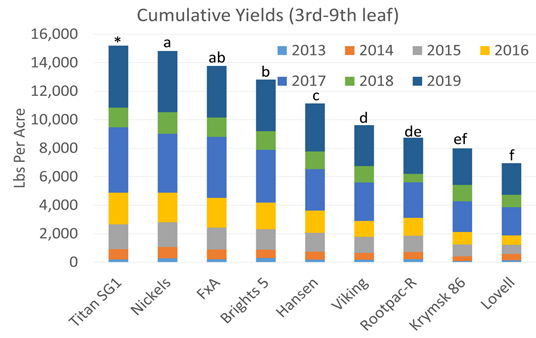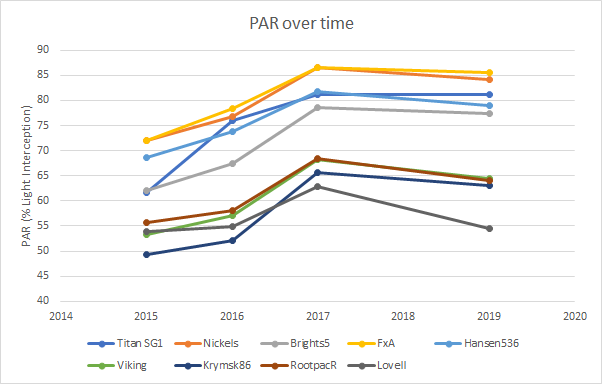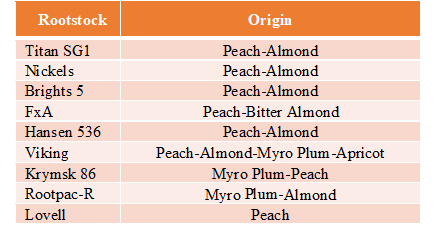Excessive boron in soil or irrigation water is not widespread in the Central Valley, but where present, it can be a substantial obstacle to almond production. A rootstock trial in Yolo County was designed to find which almond rootstocks do better or worse under high boron conditions. What follows is a summary of findings to date. What follows is a summary of findings to date. For detailed analysis of 2019 results, see pages 20-24 at the our 2019 report to the Almond Board of California.
In 2011, Carolyn Debuse, former Yolo-Solano UCCE tree crop advisor, started a trial to measure the impact of heavy, clay soils and high boron water on different almond rootstocks. ‘Nonpareil’ nursery grafted trees on eight rootstocks were planted February 2011, at 18’x22’ (110 trees per acre). Twelve Titan SG1s were added that April but not in the replicated trial. The trees have a variety of genetic backgrounds (Table 1) with different levels of boron tolerance. The trial is located in Yolo County north of Cache Creek. Boron in the irrigation water ranges from <1mg/l to 3.1 mg/l, depending on year and month.
Yield. Peach-Almond (P-A) hybrids (except Hansen 536) consistently yield highest at the trial, while Krymsk 86 and Lovell consistently yield lowest, as can be seen looking at cumulative yields over the course of the trial (Figure 1). Hansen 536, despite showing no significant difference in terms of size, continues to be lower yielding than other P-A hybrids. In 2019, the orchard was in its 9th leaf. 2019 is the first year that Rootpac-R yields have grouped with Krymsk-86 and Lovell. Viking has consistently been in the middle of the pack, yield-wise.
P-A hybrid yields in 2019 were unusually high for Yolo County, but the scale, data sheets and calculations were repeatedly checked for errors and none were found. Low yields following freeze damage in 2018 likely played a role in the high yields of 2019. Growers should not expect to consistently achieve 2019 yields under high boron conditions.

Figure 1. Boron rootstock trial cumulative yield for 3rd through 9th leaf (2013-2019). Scaled from the 5-tree sample average to per acre yields based on the 110 trees per acre spacing.
Note: Different letters indicate groupings of statistically significantly different yields. Because there are not as many later planted Titan trees, we cannot make statistical comparisons with other rootstocks.
Tree Size. Canopy light interception (PAR%) measurements is a measure of canopy size, telling us what percent of the ground was covered in shadow at mid-day by trees on different rootstocks. The bigger the tree, the bigger the shadow. Examining average PAR by rootstock over multiple years (Figure 2) shows that over by 7th leaf (2017), trees on all rootstocks had plateaued in terms of their size, as well as a clear separation of larger trees on P-A hybrid rootstocks, and smaller trees on all other rootstocks.

Figure 2. PAR from 2015-2019 (5th to 9th leaf) shows trees reaching their greatest canopy size at 7th leaf, as well as a grouping of P-A hybrids and non-P-A hybrids. Note this this graph only shows means, not statistical difference. See Table 1 for statistical differences.
Yield/Size Efficiency. Broadly speaking, it’s not surprising that smaller trees produce lower yields. So it’s worth wondering, if those smaller trees were at a tighter spacing, could they achieve the same per-acre yield as their larger P-A competitors? Dividing kernel pounds produced by PAR gives a yield/size efficiency number that can help answer this question. In 2019, the Yield/Size efficiency was much lower for trees on Krymsk 86, Rootpac-R and Lovell (around 40 lbs/1% PAR) compared to the most size efficient P-A hybrids, Titan and Nickels (greater than 50 lbs/1% PAR). This indicates that even if small trees were planted more closely, trees on non-P-A rootstocks would not catch up to P-A yields on a per-acre basis.
Given their comparable size, it is somewhat surprising that trees on Hansen 536 yielded lower than those on Titan and Nickels. It seems from the data so far that not all P-A hybrids are equally suitable for high boron conditions. Similarly, though trees on Rootpac-R, Viking, Krymsk 86 and Lovell were of comparable size, trees on Viking produced notably higher yields per unit PAR than the other small trees.
Hull Boron. Unlike most plant species, plants in the Prunus genus (almond and other stone fruit) accumulate boron in the fruit. Leaf boron levels are not a good indicator of toxicity in almond. Instead, boron in the hulls at harvest is used. In 2019, hull B was below the toxic threshold (300 ppm) in all cases, with no significant differences in hull boron content by rootstock. This is surprising given the yield differences by rootstock, and difference in hull content found in the past. It may be that low yields this year in some rootstock are a result of damage by boron to tree structure in previous years, reducing flowers per unit canopy. Given low rainfall this past winter and thus low soil leaching, I suspect we will see hull differences again in 2020.
My program will spend a few more years closely monitoring this experiment to see if yields are sustained in trees on high performing rootstocks and if we can find any more clarity on “middle of the pack” rootstocks like Viking and Rootpac-R. But for those who need to make decisions now, based on the results we have so far, it looks like Krymsk 86 and Lovell are inadvisable for high boron conditions. Consistently lower yields from trees on Hansen 536 indicates caution is warranted in thinking all P-A hybrids will perform equally well under high boron stress. Cumulative yields indicate that Titan, Nickels, and FxA are the safest bet for a productive orchard under high boron conditions.



Leave a Reply